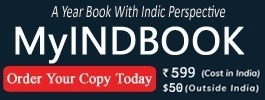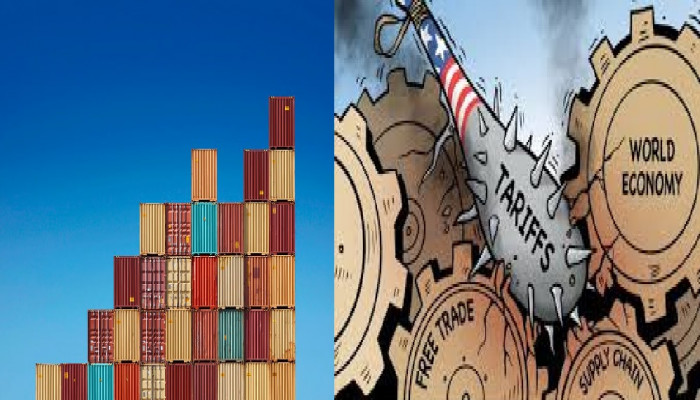The Economic River: How Tariffs under Trump Altered the Global Current of Trade
- In Economics
- 09:12 AM, Aug 05, 2025
- Dr Ryan Baidya
We often speak of the "economy" as an abstract entity, a complex web of statistics and indicators. But at its heart, the economy can be understood through a surprisingly simple yet powerful model: a reciprocal flow. Imagine two interconnected currents: one carrying goods and services, the tangible outputs of human endeavour, and the other flowing in the opposite direction, carrying money, the universal medium of exchange and valuation. The strength and speed of this two-way flow dictate the health and vitality of any economic system.
In a thriving economy, this "economic river" flows swiftly and robustly. Consumers purchase goods and services, sending money to businesses. Businesses, in turn, use that money to produce more goods and services, pay wages to workers (who then become consumers), and invest in future growth. This circular flow of income, as economists call it, is the engine of prosperity. Governments, financial institutions, and international trade add complexity to this model, but the fundamental principle remains: a continuous exchange of value.
However, this flow is not always smooth. It can be accelerated or impeded by various factors, including government policies. A prime example of such intervention in recent times is the implementation of significant tariff policies under the administration of President Donald Trump. These policies, imposing taxes on imported goods from various countries, represent a deliberate attempt to manipulate the direction and volume of our economic river.
The stated intention behind these tariffs was multifaceted: to reduce trade deficits, protect domestic industries from foreign competition, and encourage companies to bring manufacturing back to the United States. In the context of our "reciprocal flow" model, the goal was to:
Slow the Outflow of Money: By increasing the cost of imported goods through tariffs, the aim was to make them less attractive to American consumers and businesses, thereby reducing the amount of money leaving the country to pay for these imports.
Boost the Domestic Flow of Goods and Services: The expectation was that as imported goods became more expensive, domestic alternatives would become more competitive, leading to increased demand for American-made products and services. This would, in theory, stimulate domestic production and employment, strengthening the internal flow of our economic river.
Generate Government Revenue: Tariffs, being a form of tax, generate revenue for the government, creating a new inflow of money that could be used for various public purposes.
However, the reality of these policies, viewed through the lens of the reciprocal flow, has been far more nuanced and often contradictory to the intended outcomes. While tariffs did indeed make certain imported goods more expensive, they also led to several significant disruptions in the natural flow of the economic river.
Increased Costs for Consumers and Businesses: American consumers and businesses that relied on imported components or goods often faced higher prices. This increased the cost of living and production, potentially slowing down overall economic activity – a drag on the flow.
Retaliatory Tariffs and Reduced Exports: The imposition of tariffs by the U.S. often triggered retaliatory tariffs from other countries on American exports. This directly hindered the outflow of American goods and services, weakening a crucial component of our economic river and reducing the inflow of money from overseas buyers. American farmers, manufacturers, and other export-oriented industries often found themselves at a disadvantage.
Uncertainty and Disrupted Supply Chains: The unpredictable nature of tariff impositions and the potential for escalation created significant uncertainty for businesses. This uncertainty made long-term planning and investment more difficult, potentially leading to a cautious approach and a slower rate of economic flow. Global supply chains, finely tuned over decades, were disrupted as businesses scrambled to find alternative sources or adjust to the new cost structures.
A Potential "Damming" Effect: Rather than simply redirecting the flow, many argued that the tariffs created blockages in the global economic river. The reduced flow of imports, coupled with retaliatory measures hindering exports, risked shrinking the overall volume of trade and economic activity, leaving the entire system less dynamic and potentially less prosperous.
In conclusion, understanding the economy as a reciprocal flow of goods and services in one direction and money in the other provides a valuable framework for analysing the impact of policies like the tariffs enacted under President Trump. While the intention may have been to reshape the flow to favour domestic interests, the actual consequences often involved hindering the natural currents of global trade, creating uncertainty, and potentially diminishing the overall vigour of the economic river. The lesson learned is that interventions in such a complex and interconnected system can have far-reaching and often unintended consequences on the very flows that drive economic prosperity.
References for Further Reading
- Bown, Chad P., and Douglas A. Irwin. The Trump Trade War: A Timeline. Peterson Institute for International Economics, 2019. https://www.piie.com/blogs/trade-and-investment-policy-watch/trump-trade-war-timeline.
- Crowley, Meredith A. “Trade War: The Clash of Economic Systems Endangering Global Prosperity.” Annual Review of Economics 12 (2020): 503–526. https://doi.org/10.1146/annurev-economics-081919-050801.
- Irwin, Douglas A. Clashing over Commerce: A History of US Trade Policy. Chicago: University of Chicago Press, 2017.
- Li, Chunding, John Whalley, and Shunming Zhang. “The Impact of the 2018–2019 US Tariffs on Chinese Exports: A Quantitative Analysis.” China Economic Journal 13, no. 1 (2020): 1–20. https://doi.org/10.1080/17538963.2020.1726906.
- Lovely, Mary E., and Yang Liang. Trump Tariffs Primarily Hit Multinational Supply Chains, Harm US Technology Competitiveness. Peterson Institute for International Economics, Policy Brief 18-12, May 2018.
- Rodrik, Dani. Straight Talk on Trade: Ideas for a Sane World Economy. Princeton: Princeton University Press, 2017.
- Subramanian, Arvind, and Shang-Jin Wei. “The WTO Promotes Trade, Strongly but Unevenly.” Journal of International Economics 72, no. 1 (2007): 151–175. https://doi.org/10.1016/j.jinteco.2006.07.007.
- U.S. International Trade Commission. Economic Impact of Trade Agreements Implemented under Trade Authorities Procedures, 2016 Report. Washington, DC: USITC, 2016.
- World Trade Organization. World Trade Report 2020: Government Policies to Promote Innovation in the Digital Age. Geneva: WTO Publications, 2020.
Disclaimer: The opinions expressed within this article are the personal opinions of the author. MyIndMakers is not responsible for the accuracy, completeness, suitability, or validity of any information on this article. All information is provided on an as-is basis. The information, facts or opinions appearing in the article do not reflect the views of MyindMakers and it does not assume any responsibility or liability for the same.







Comments